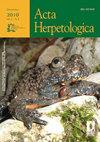亚美尼亚一种蜥蜴(Darevskia sp.)群落的短期空间结构
IF 0.9
4区 生物学
Q4 ZOOLOGY
引用次数: 5
摘要
驱动定居生物群落空间格局的因素仍然知之甚少。在这种情况下,孤雌生殖动物有助于测试性和种间相互作用对空间格局的贡献。因此,无性物种和有性物种的混合群落在空间上被组织为单一性别物种,性别随机分布且相互独立。在繁殖期内,测定了由一种有性物种(D. valentini)、两种无性物种(D. armeniaca、D. unisexualis)及其杂种组成的亚美尼亚达尔瓦斯基岩蜥蜴群落的瞬时空间结构。分析了群落的具体组成和生境的物种分离。我们使用Ripley的K距离函数来测量聚类的空间格局,并使用Delaunay的三角剖分来识别聚类及其具体组成。我们通过计算物种对之间的重叠,比较雄性与其他雄性和雄性与雌性的成对距离,以及使用对数线性模型比较两性和生殖模式(无性和有性)在植物覆盖和高度上的频率来估计物种之间的空间隔离。物种空间结构呈簇状分布,各簇中均有孤雌生殖(主要为亚美尼亚瓢虫)或其杂种。雌虫和雄虫均集中在植物覆盖中等的地区。D. armeniaca和D. valentini重叠度最高。男性与男性的关系比与女性的关系更亲密。该群落表现出类似于单一性别物种种群的瞬时空间格局。空间统计为分析物种群落的空间结构提供了新的视角。本文章由计算机程序翻译,如有差异,请以英文原文为准。
Short term spatial structure of a lizard (Darevskia sp.) community in Armenia
Factors driving the spatial patterns of communities of sedentary organisms are still poorly understood. In this context parthenogenetic animals are useful to test the contribution of sexual and interspecific interactions on spatial patterns. As such, mixed communities of asexual and sexual species are expected to be spatially organized as a single sexual species, with sexes randomly distributed and mutually independent. During the reproductive period, we determined the instantaneous spatial structure in a community of Darevskia rock lizards from Armenia composed of one sexual species ( D. valentini ), two asexual species ( D. armeniaca , D. unisexualis ), and their hybrids. We also analysed the specific composition of clusters and the species segregation by habitat. We used the Ripley’s K distance function to measure clustering spatial patterns, and the Delaunay’s triangulation to identify the clusters and their specific composition. We estimated the spatial segregation among species by calculating the overlap between species pairs, by comparing pairwise distances from males to other males and from males to females, and by comparing the frequencies of both sexes and reproduction modes (asexual and sexual) in plant cover and height using log-linear models. Species displayed a clustered spatial structure, with parthenogens (mainly D. armeniaca ) or their hybrids in all clusters. Females and males were concentrated in areas with medium plant cover. D. armeniaca and D. valentini were the species with the highest overlap. Males were closer to males than to females. This community displays an instantaneous spatial pattern resembling a population of a single sexual species. Spatial statistics offer new insights to analyse the spatial structure of species communities.
求助全文
通过发布文献求助,成功后即可免费获取论文全文。
去求助
来源期刊

Acta Herpetologica
ZOOLOGY-
CiteScore
1.20
自引率
12.50%
发文量
10
审稿时长
6 months
期刊介绍:
Acta Herpetologica, a journal open to academics all over the world, offers itself as a new site for the presentation and discussion of the most recent results in the field of research on Amphibians and Reptiles, both living and extinct. The official journal of the Societas Herpetologica Italica (S.H.I.), Acta Herpetologica publishes original works – extended articles, short notes and book reviews – mostly in English, dealing with the biology and diversity of Amphibians and Reptiles.
 求助内容:
求助内容: 应助结果提醒方式:
应助结果提醒方式:


